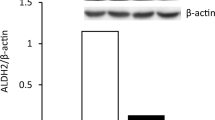Abstract
In the hippocampus, short-term exposure to ethanol (EtOH) has been shown to inhibit some functions, and nitric oxide (NO) is an important modulator of physiologic processes. In this study, investigators explored the effects of EtOH on the total number of neurons in rat CA regions and the possible neuroprotective role of NO. The role of NO in rats given EtOH was examined with the use of a nonselective inhibitor of NOS (N[G]-nitro-L-arginine methyl ester [L-NAME], D[G]-nitro-L-arginine methyl ester [D-NAME]), a central selective inhibitor of NOS (7-NI), and a donor of NO (L-arginine). Toward this end, rats were randomly divided into 6 groups: control (saline 3 g/kg intraperitoneal [ip]), ethanol (ethanol 3 g/kg ip), L-NAME (ethanol 3 g/kg ip + L-NAME 60 mg/kg ip), L-arginine (ethanol 3 g/kg ip + L-arginine 1 g/kg ip), D-NAME (ethanol 3 g/kg ip + D-NAME 60 mg/kg ip), and 7-NI (ethanol 3 g/kg ip + 7-NI 40 mg/kg ip). Blood ethanol concentrations were measured 90 min after EtOH administration. Means (value±standard deviation) of total pyramidal neuronal numbers in the right hippocampus were estimated using the optical fractionator counting method. Values were as follows: 446,558±6207, 483,517±20,311, 464,588±30,637, 479,688±10,780, 458,294±17,770, and 477,281 ±7641 in the control, ethanol, L-arginine, 7-NI, L-NAME, and D-NAME groups, respectively. No significant differences were observed between groups (P > .05). The results of the present study imply that short-term administration of EtOH does not affect total pyramidal neuronal number in the right hippocampus of the rat. Furthermore, NO does not change the effects of short-term EtOH on total pyramidal neuronal number in the right hippocampal CA regions of the rat. Additional studies are needed to clarify the role of NO and NOS inhibition in the effects associated with EtOH given on a short-term basis.
Similar content being viewed by others
References
Nordmann R, Ribiere C, Rouach H. Implication of free radical mechanisms in ethanol-induced cellular injury.Free Radic Biol Med. 1992; 12: 219–240.
Reyes E, Ott S, Robinson B. Effects of in utero administration of alcohol on glutathione levels in brain and liver.Alcohol Clin Exp Res. 1993; 17: 877–881.
Uysal M, Kutalp G, Özdemirler G, Aykaç G. Ethanol-induced changes in lipid peroxidation and glutathione content in rat brain.Drug Alcohol Depend. 1989; 23: 227–230.
Clarren SK, Astley SJ, Bowden DM, et al. Neuroanatomic and neurochemical abnormalities in nonhuman primate infants exposed to weekly doses of ethanol during gestation.Alcohol Clin Exp Res. 1990; 14: 674–683.
Tan SE, Berman RF, Abel EL, Zajac CS. Prenatal alcohol exposure alters hippocampal slice electrophysiology.Alcohol. 1990; 7: 507–511.
Mattson SN, Riley EP, Sowell ER, Jernigan TL, Sobel DF, Jones KL. A decrease in the size of the basal ganglia in children with fetal alcohol syndrome.Alcohol Clin Exp Res. 1996; 20: 1088–1093.
Barnes DE, Walker DW. Prenatal ethanol exposure permanently reduces the number of pyramidal neurons in rat hippocampus.Dev Brain Res. 1981; 1: 333–340.
Tran TD, Kelly SJ. Critical periods for ethanol-induced cell loss in the hippocampal formation.Neurotoxicol Teratol. 2003; 25: 519–528.
Dawson VL, Dawson TM. Physiological and toxicological actions of nitric oxide in the central nervous system.Adv Pharmacol. 1995; 34: 323–342.
Uzbay IT, Oglesby MW. Nitric oxide and substance dependence.Neurosci Biobehav Rev. 2001; 25: 43–52.
Costa ET, Ferreira VM, Valenzuela CF. Evidence that nitric oxide regulates the acute effects of ethanol on rat N-methyl-D-aspartate receptors in vitro.Neurosci Lett. 2003; 343: 41–44.
Moncada S, Higgs A, Furchgott R. International Union of Pharmacology nomenclature in nitric oxide research.Pharmacol Rev. 1997; 49: 137–142.
Egberongbe YI, Gentleman SM, Falkai P, Bogerts B, Polak JM, Roberts GW. The distribution of nitric oxide synthase immunoreactivity in the human brain.Neuroscience. 1994; 59: 561–578.
Bonthius DJ, Tzouras G, Karacay B, et al. Deficiency of neuronal nitric oxide synthase (nNOS) worsens alcohol-induced microencephaly and neuronal loss in developing mice.Dev Brain Res. 2002; 138: 45–59.
Ferreira VM, Valenzuela CF, Morato GS. Role of nitric oxide-dependent pathways in ethanol-induced anxiolytic effects in rats.Alcohol Clin Exp Res. 1999; 23: 1898–1904.
West MJ, Slomianka L, Gundersen HJG. Unbiased stereological estimation of the total number of neurons in the subdivisions of the rat hippocampus using the optical fractionator.Anat Rec. 1991; 231: 482–497.
Con N, Canbilen A, Bradley PM, Kaplan S. Quantitative features of the nucleus rotundus in the brain of pre- and post-hatch chicks.Dev Brain Res. 2003; 146: 71–77.
Gundersen HJ. Notes on the estimation of the numerical density of arbitrary particles: the edge effect.J Microsc. 1977; 111: 219–223.
Gundersen HJ, Jensen EB. The efficiency of systematic sampling in stereology and its prediction.J Microsc. 1987; 147: 229–263.
Matthews DB, Silver JR. The use of acute ethanol administration as a tool to investigate multiple memory systems.Neurobiol Learn Mem. 2004; 82: 299–308.
Cameron HA, McKay RD. Adult neurogenesis produces a large pool of new granule cells in the dentate gyrus.J Comp Neurol. 2001; 435: 406–417.
Nixon K, Crews FT. Binge ethanol exposure decreases neurogenesis in adult rat hippocampus.J Neurochem. 2002; 83: 1087–1093.
Berry RB, Matthews DB. Acute ethanol administration selectively impairs spatial memory in C57BL/6J mice.Alcohol. 2004; 31: 9–18.
Persson MG, Gustafsson LE. Ethanol can inhibit nitric oxide production.Eur J Pharmacol. 1992; 224: 99–100.
Zhang R, Zhang L, Zhang Z, et al. A nitric oxide donor induces neurogenesis and reduces functional deficits after stroke in rats.Ann Neurol. 2001; 50: 602–611.
Jang MH, Shin MC, Kim EH, Kim CJ. Acute alcohol intoxication decreases cell proliferation and nitric oxide synthase expression in dentate gyrus of rats.Toxicol Lett. 2002; 133: 255–262.
Ikeda M, Komiyama T, Sato I, Himi T, Murota SI. Neuronal nitric oxide synthase resistant to ethanol.Life Sci. 1999; 64: 1623–1630.
Author information
Authors and Affiliations
Corresponding author
Rights and permissions
About this article
Cite this article
Kozan, R., Ayyildiz, M., Bas, O. et al. Short-term ethanol administration does not change the total pyramidal neuron number of the rat hippocampus: A stereologic study. Adv Therapy 24, 231–238 (2007). https://doi.org/10.1007/BF02849890
Issue Date:
DOI: https://doi.org/10.1007/BF02849890




